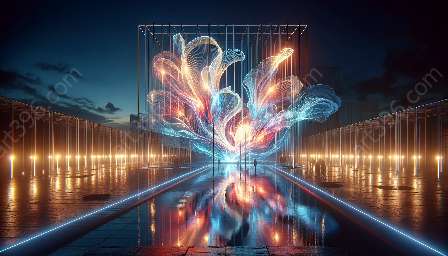Light art is a fascinating medium that combines technology, creativity, and interactivity to create unique experiences that challenge our perceptions of light and space. This article will delve into the principles of light art, exploring its innovative nature and the ways it engages with interactivity.
Understanding Light Art
Before we can delve into the principles of light art, it's important to understand what exactly light art is. Light art encompasses a wide range of artistic practices that use light as a primary medium. This can include installations, sculptures, performances, and more, all of which utilize light in innovative and creative ways.
One of the defining characteristics of light art is its interactivity. Many light art installations invite viewers to actively engage with the artwork, blurring the lines between observer and participant. This interactive aspect is a key principle of light art, as it creates immersive and dynamic experiences that challenge traditional notions of art and spectatorship.
Principles of Light Art
1. Use of Technology: Light art often incorporates cutting-edge technologies, such as LED lights, projection mapping, and interactive sensors. These technological elements allow artists to push the boundaries of what is possible with light, creating dynamic and visually stunning compositions.
2. Play with Perception: Light art manipulates the viewer's perception of space, time, and color. By utilizing light in unexpected ways, artists can transform ordinary environments into extraordinary and thought-provoking experiences.
3. Emphasis on Interactivity: Interactivity is a central principle of light art. By inviting viewers to actively engage with the artwork, artists create immersive and participatory experiences that break down the traditional barriers between art and audience.
4. Exploration of Spatial Relationships: Light art often plays with spatial relationships, using light to define and redefine the contours of architectural spaces. Through this exploration, artists challenge our understanding of the environments we inhabit, creating dynamic and transformative experiences.
Interactivity in Light Art
The concept of interactivity is central to the practice of light art. Interactivity in light art can take many forms, including motion sensors that respond to the movements of viewers, interactive elements that allow audiences to manipulate the light and color of an installation, and audio-visual experiences that respond to sound and movement.
One of the most exciting aspects of interactivity in light art is its ability to create dynamic and ever-changing experiences. By allowing viewers to actively engage with the artwork, artists can create installations that evolve and adapt in real time, offering new perspectives and experiences with each interaction.
Groundbreaking Light Art Installations
Throughout history, artists have created groundbreaking light art installations that have pushed the boundaries of creativity and technology. From the immersive light sculptures of Olafur Eliasson to the interactive LED installations of teamLab, light art continues to captivate and inspire audiences around the world.
By embracing interactivity and pushing the limits of what is possible with light, these artists have redefined the principles of light art, creating innovative and transformative experiences that challenge our perception of art and space.
As technology continues to advance, the principles of light art will evolve alongside it, offering endless opportunities for artists to explore new forms of interactivity, innovation, and creativity.

